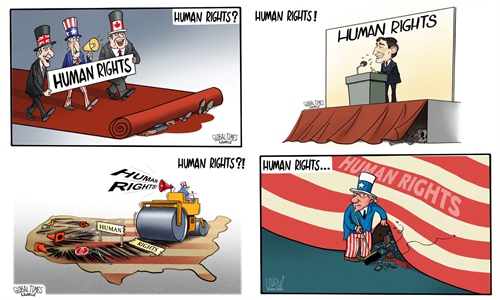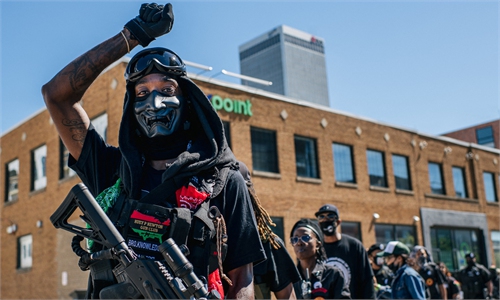
Conservative activist and US President Donald Trump supporter Jack Posobiec (right) gets into an argument with anti-racism protesters in front of the Emancipation Memorial at Lincoln Park in Washington, DC. Photo: AFP
Had civil right activists who were celebrating the end of notorious Jim Crow laws in 1965 time-travelled to American cities in 2021, they could have been overwhelmed by unspeakable shock and confusion: A de facto form of racial segregation has come back. While Black people back in 1960s were choked by a series of discriminative laws, their descendants today have fallen prey to something untouchable but even more pervasive and painful - an invisible hand that is defined by American journalist Isabel Wilkerson as a "caste system".Readers may wonder why a caste system that is usually related to India one day becomes American. The Rev. Dr Martin Luther King Jr had experienced the same sense of strangeness in 1959 when he was visiting with the high school students whose families had been untouchables in India. "Young people," the principal said, "I would like to present to you a fellow untouchable from the United States of America."
In her book Caste: The Origins of Our Discontents, Wilkerson describes the caste system in the US as a "shape-shifting, unspoken, race-based caste pyramid." She argues, "In America, race is the primary tool and the visible decoy for caste."
The shameful fact is: While entering the third decade of the 21st century, the US segregation is getting worse compared to decades ago.
Neighborhoods are more segregated. Of all 209 metro regions in the US with more than 200,000 residents, 169, or 81 percent, were more segregated in 2019 than they were in 1990.
Schools are more segregated. Black children are five times as likely as white children to attend schools that are highly segregated by race and ethnicity.
Hospitals are more segregated. Many African-American and low-income patients are largely shut out of major teaching hospitals, where the most advanced medical practices are available.
Racial segregation is evidently accelerated by the COVID-19 pandemic. US CDC data shows that the death rates among Black and Hispanic/Latino people are much higher than those for white people. Stark inequalities in COVID-19 outcomes also exist for the American Indian and Alaska Native population as well.
Caste is like the underlying grammar behind the language of race, the invisible guide of not just where Americans live, but where they travel daily. Data collected from millions of smartphones and wearable devices suggests people of different races don't only live in different neighborhoods, but also eat, drink, shop, socialize and travel in different neighborhoods.
Perhaps the most dangerous thing about America's caste system is not openly hateful conducts but that many ordinary Americans could be casteist: They unconsciously wish to preserve Blacks as a subordinate caste, and are content to do nothing to change the race hierarchy.
Dr King would be appalled but not surprised by rampant racism in today's America.
It is all about White Supremacy at play - the entrenched and enduring patrimony of superiority that is deeply embedded in America's national psyche, baked into its culture, and passed down from one generation to the next.
America's caste system won't disappear until White Supremacy is eradicated.
But "White Supremacy won't die until White people see it as a White issue they need to solve rather than a Black issue they need to empathize with." As Dwayne Reed, a US rapping educator tweets.
Could this really happen? And when?
The author is a commentator on international affairs. xinping604@gmail.com


